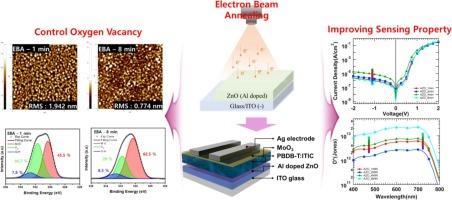低温电子束退火提高有机光电探测器的性能
IF 7.9
2区 材料科学
Q1 MATERIALS SCIENCE, MULTIDISCIPLINARY
引用次数: 0
摘要
有机光电探测器(opd)由于其灵活性、低成本和可扩展性而成为下一代光电器件的有希望的候选者。提高OPD性能需要使用低温工艺优化关键层,如电子传输层(ETL),以防止热降解。本研究探索使用低温电子束退火(EBA)来提高al掺杂ZnO基ETLs的性能。系统分析了EBA辐照时间(1 ~ 8 min)对AZO膜结构、形态和电学性能的影响。EBA有效调节氧空位,降低表面粗糙度,降低陷阱密度和泄漏电流,同时增强电荷输运。与传统退火ETL相比,经过8分钟EBA处理的ETL的OPD具有更好的探测能力(在0 V时为2.22 × 1013 Jones),并且显着降低了泄漏电流。重要的是,低温EBA工艺保留了AZO的非晶态,使其适用于热敏和柔性衬底。这些发现表明,EBA是一种强大的、可扩展的opd ETL优化方法,为实现高性能、节能和柔性光电器件提供了一条途径。本文章由计算机程序翻译,如有差异,请以英文原文为准。

Improving the performance of organic photodetectors by low-temperature electron beam annealing
Organic photodetectors (OPDs) are promising candidates for next-generation optoelectronic devices due to their flexibility, low cost, and scalability. Enhancing OPD performance requires optimizing key layers such as the electron transport layer (ETL) using low-temperature processes to prevent thermal degradation. This study explores the use of low-temperature electron beam annealing (EBA) to improve the performance of Al-doped ZnO (AZO)-based ETLs. The impact of EBA irradiation time (1–8 min) on the structural, morphological, and electrical properties of AZO films was systematically analyzed. EBA effectively modulated oxygen vacancies and reduced surface roughness, lowering trap density and leakage current while enhancing charge transport. An OPD with an ETL treated by 8 min of EBA exhibited superior detectivity (2.22 × 1013 Jones at 0 V) and significantly reduced leakage current compared to a device with conventionally annealed ETLs. Importantly, the low-temperature EBA process preserved the amorphous state of AZO, making it suitable for heat-sensitive and flexible substrates. These findings demonstrate that EBA is a powerful, scalable method for ETL optimization in OPDs and offers a pathway toward high-performance, energy-efficient, and flexible optoelectronic devices.
求助全文
通过发布文献求助,成功后即可免费获取论文全文。
去求助
来源期刊

Materials & Design
Engineering-Mechanical Engineering
CiteScore
14.30
自引率
7.10%
发文量
1028
审稿时长
85 days
期刊介绍:
Materials and Design is a multi-disciplinary journal that publishes original research reports, review articles, and express communications. The journal focuses on studying the structure and properties of inorganic and organic materials, advancements in synthesis, processing, characterization, and testing, the design of materials and engineering systems, and their applications in technology. It aims to bring together various aspects of materials science, engineering, physics, and chemistry.
The journal explores themes ranging from materials to design and aims to reveal the connections between natural and artificial materials, as well as experiment and modeling. Manuscripts submitted to Materials and Design should contain elements of discovery and surprise, as they often contribute new insights into the architecture and function of matter.
 求助内容:
求助内容: 应助结果提醒方式:
应助结果提醒方式:


